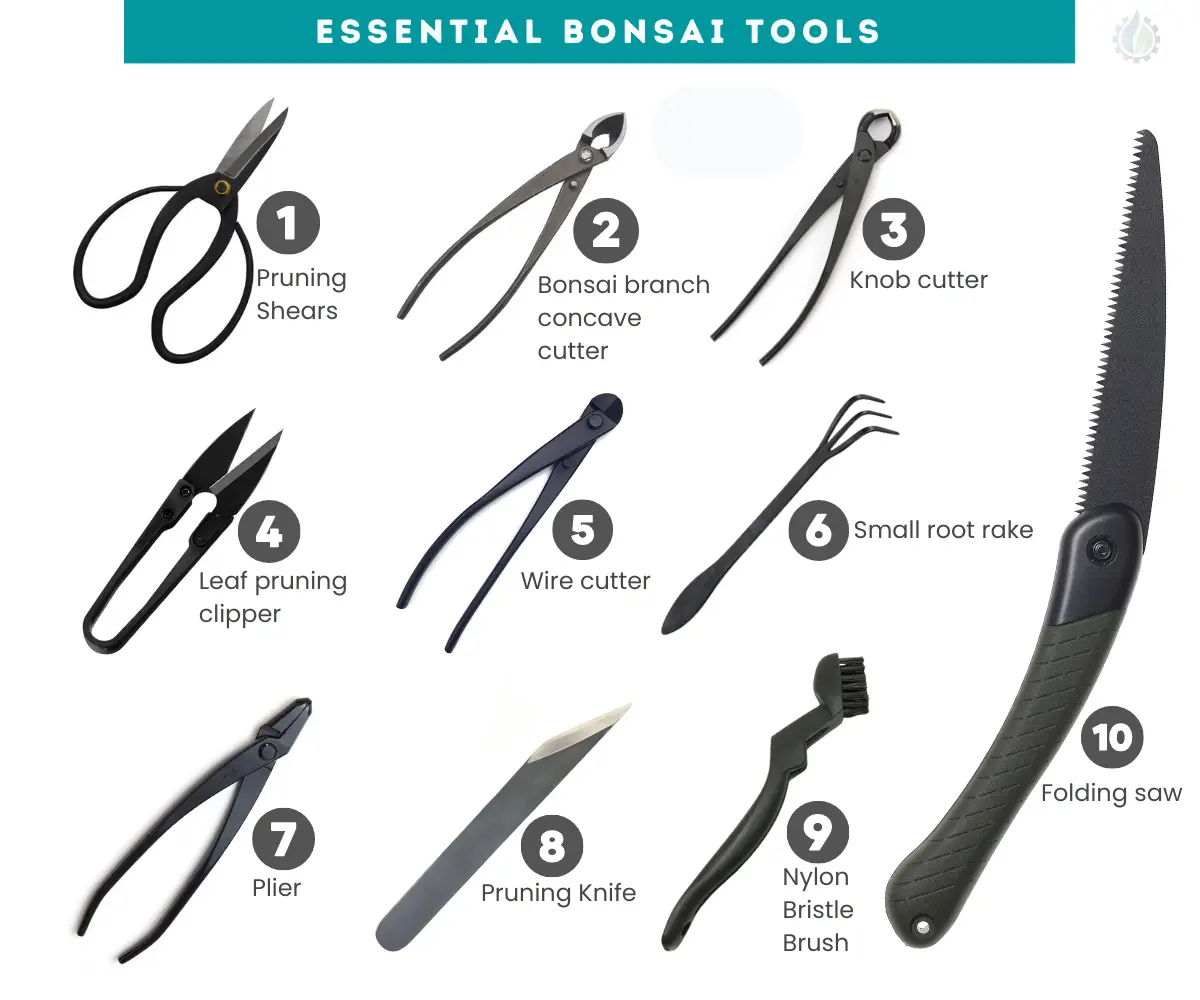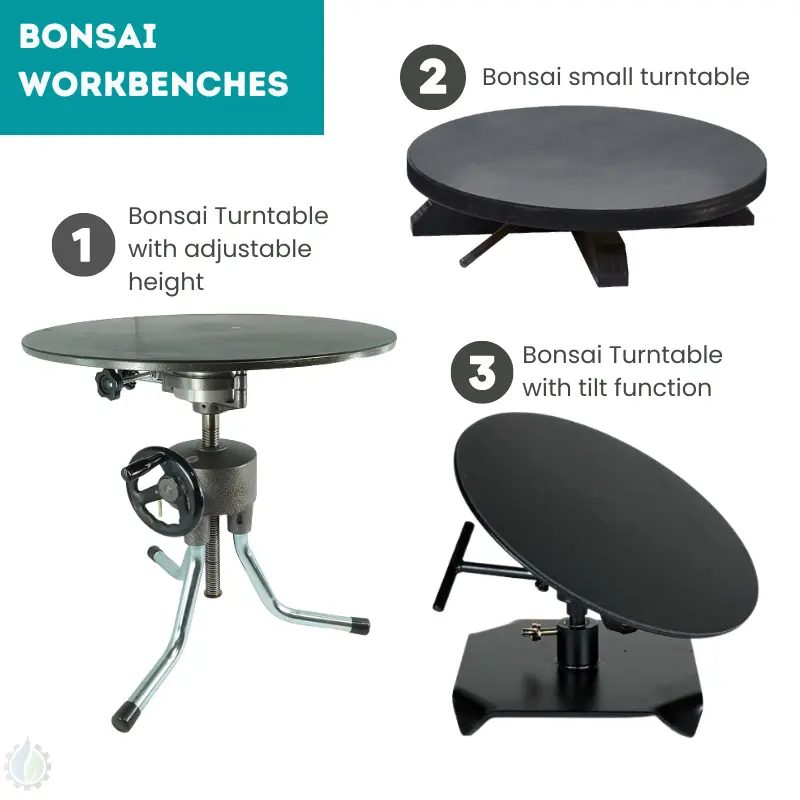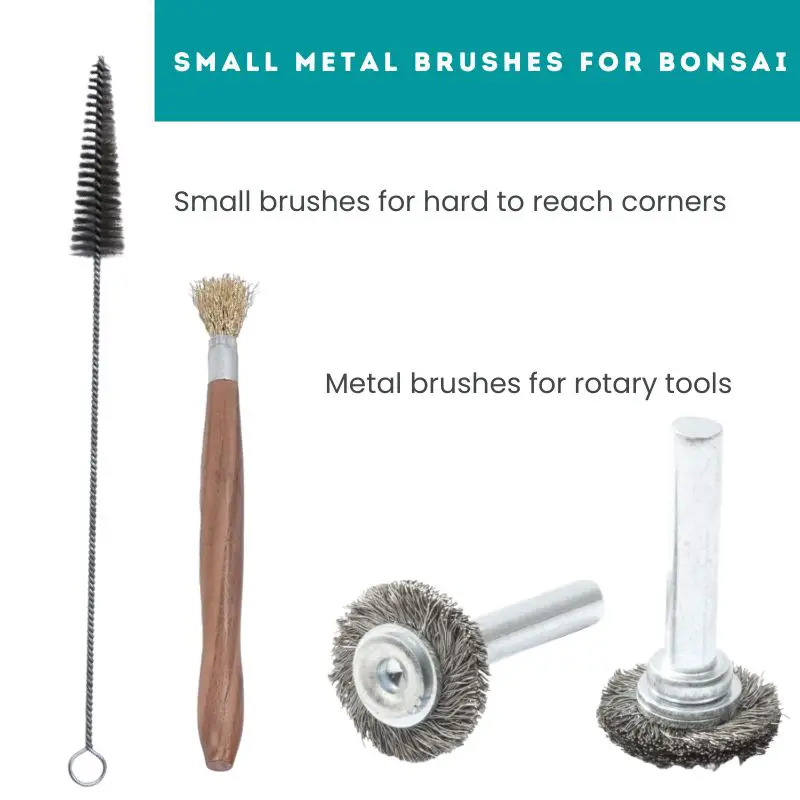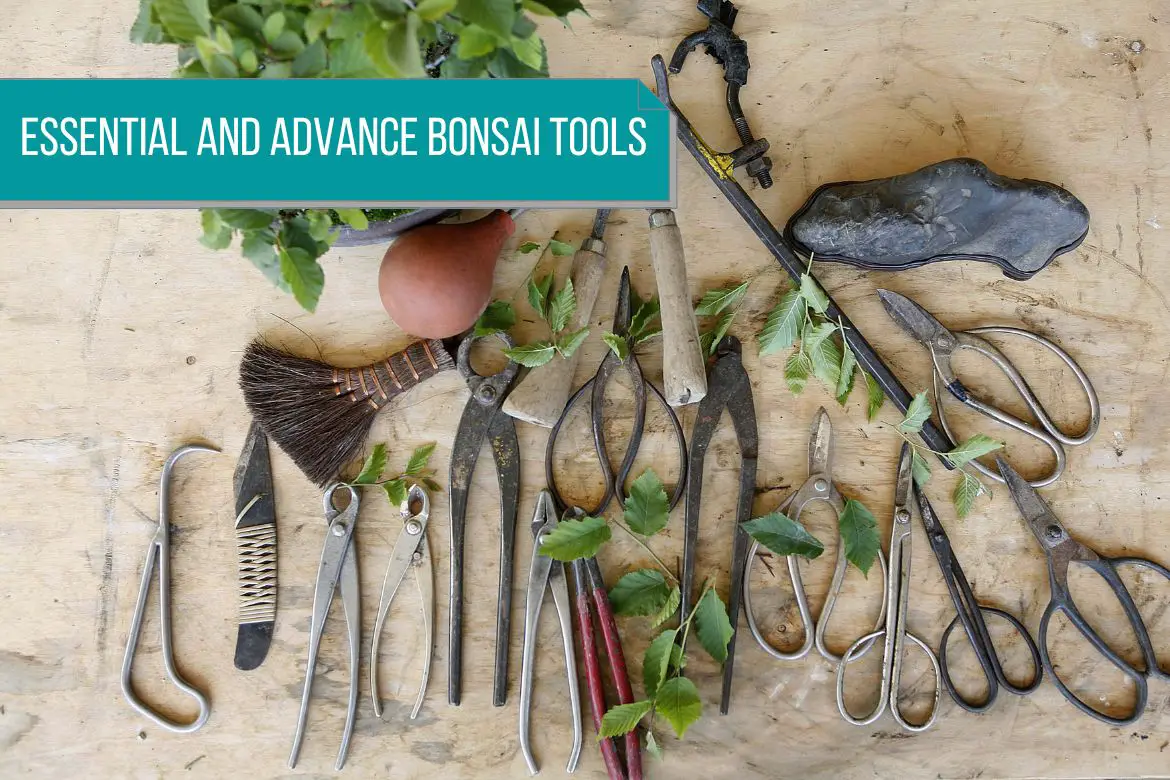When it comes to bonsai tools, there are two important principles to keep in mind.
- Traditionally, bonsai tools are specialized tools designed with a specific purpose in mind. It is important to choose the right bonsai tool for the job at hand.
- In addition to choosing the right tool, it’s equally important to use a well-maintained tool. A well-maintained tool will make your bonsai experience fun and relaxing. Also, the tools with last for a long time, eventually saving you money and reduce the chances of pest and diseases.
There are a wide range of bonsai tools available on the market. However, in case you are a beginner, go with just the essential tools. Test the waters and see if bonsai making is something which gives you pleasure.
Refer to our bonsai care guide page. Here we have listed more than 100 bonsai tree species with their detailed growing guide. Also, read how to take care of your bonsai tools.
Also, buying bonsai tool sets with a large assortment of tools requires a considerable amount of investment. So before spending a large sum of money, test your bonsai skills with the basic essential tools. For most of your beginner bonsai work, these tools should be enough.
The need for more advanced and specialty tools will come later when:
- You gain more experience with the art of bonsai
- You start experimenting with different bonsai styles
- Your bonsai tree collection grows
- Your bonsai becomes large or you buy a big bonsai specimen
That being said, advanced tools will definitely give you more freedom and make your bonsai work easier. Furthermore, it is also wise to know what these specialty tools are meant for.
I have divided this article into three sections:
- Bonsai essential tools
- Bonsai turntables / bonsai workbenches
- Bonsai advance tools
Essential Bonsai tools for beginners

(1) Bonsai Pruning Shears
The art of bonsai requires shears for trimming buds, thinning foliage, and defoliating, all of which require shears. Several sizes and shapes of bonsai shears are available, but to get started, begin with just one good quality bonsai scissors.
There are many types of bonsai pruning shears : Leaf pruning shears, branch pruning shears, bud pruning shears, root pruning shears.
You will learn the technicalities of these shears as you gain more experience. Like I said before, a medium sized good quality shear is more than enough.
(2) Bonsai concave branch cutter
This is one of the most important bonsai tools. Much like pruning shears, these are also available in many sizes. Once again, medium sized branch cutter is enough for bonsai starters.
It is useful in removing flush from the trunk with a slight concave cut. This concave cut allows the bark to cover the pruning wound and helps in keeping the trunk smooth.
Wood carving tools / Wood gouges (discussed in later section) can also be used to create similar slight cavity on the cuts, to create the same effect.
(3) Knob cutter / Wen cutter
These cutters can be used to remove the remaining small knobs left on the trunk of the bonsai tree after branch pruning. These knobs are hard to cut with a saw.
These spherical knob cutters can also be used for tidying up old wounds on the bonsai tree.
(4) Leaf pruning clippers / Defoliating shears
Defoliating shears, or leaf trimmers, are the preferred tools for removing unwanted leaves and buds because they remove foliage quickly and precisely.
There are many styles and sizes of leaf trimmers available, and whether you buy a pair with straight blades or angled blades depends on your preference.
(5) Wire cutters
As the name implies, these are used to cut training wires or wires used at the time of potting / repotting and stabilizing the bonsai tree.
Again, these tools are available in various sizes. Choose a medium sized wire cutter to start with. (Depends on the thickness of the wire you are using).
IMPORTANT: Do not confuse these with the regular wire cutters you find in your tool box. These are specifically designed for cutting bonsai wires. Also, unlike other electrical wire cutters, bonsai wire cutters have a rounded head so that they don’t damage the bark of the tree.
(6) Small root rake
You can use rakes for several purposes, including working the bonsai soil when repotting a bonsai, removing soil around the roots of the bonsai. You can also turn over the soil as part of your bonsai’s general care.
In addition to the bonsai rake, most bonsai rakes also feature a spatula at the other end. Using this spatula, you can firmly press down the bonsai soil around the base of the bonsai or gently pry off any dead bark from the tree.
(7) Pliers / Jinning pliers / Long nose pliers
This would be considered a less essential tool. An ordinary pair of pliers can also be used for its job. However, I’m mentioning these pliers because it’s a wise idea to keep your garage pliers and bonsai pliers separate.
These pliers are used to create jins. These pliers can also be used to bend wires.
(8) Bonsai Pruning knife
Pruning knife is a good tool to tidy up the pruning cuts. This can also be used for cutting roots inside the bonsai pot.
(9) Plastic / Nylon Bristle brush
To clean a tree without damaging the bark, nylon bristle brushes are used. An old soft toothbrush can also be used for this purpose.
This brush can also be used to clean the bonsai containers as well as the algae that forms on the rocks.
The soil on the upper surface of the roots can be removed using this brush. Thus exposing the beautiful top root structure of the bonsai tree.
(10) Saw / Folding saw
These saw are one of the most important tools you can have in your bonsai tool set. Hence, these come under the essential tools for bonsai.
These can be used to cut large branches (for example when doing a major pruning job at the time of winter). These can also be used to cut the large roots or the root ball of the bonsai tree.
It is recommended to use pull saw. Because using a pull saw reduces the chances of bending of the saw. And hence, the pruning cut is much cleaner.
Bonsai workbench
We have finished the essential bonsai tools for starters and now are going to take a dive into the realm of bonsai tools and accessories used by advance bonsai enthusiasts.
Bonsai workbenches also known as bonsai turntables don’t come under bonsai essentials. However, they will be of great help – especially on those Sundays when you want to sit at a place and not move around while working on your bonsai tree.
The price of these work benches can range from 50 dollars to few hundred dollars.

(1) Bonsai turntable with adjustable height
This turntable has an adjustable height. The height adjustment mechanism of the turntable can be hand cranked, hydraulic or pneumatic.
These tables are mostly made up of steel (some are also made up of wood) and are able to withstand heavy weight of a fully formed bonsai tree and its bonsai container.
The diameter of the turntable can range from 11 inches to 23 inches.
Hence, the price also varies depending on the complexity of height adjustment mechanism used, diameter of the table, quality of the steel/iron/wood and the brand popularity.
(2) Small basic bonsai turntable
These turntables do not have any additional feature. However, the lack of height adjustment and tilt function should not be a deal breaker for you.
You can easily keep this turn table on a raised table (adjusted to your desired height) and then work on your bonsai. This will also save you good amount of money. You can get a decent one in 50 – 60 USD.
(3) Bonsai turntable with tilt function
This turntable gives you the ability to tilt your bonsai tree at an angle while working on it. By tilting the bonsai tree, you can easily examine your bonsai from all the angles while standing or sitting comfortably. Hence giving you more angle of approaches to work on your bonsai.
Simply strap your bonsai pot on the table (there will be hooks provided on the side or bottom of the table to attach your tension straps) and start using the tilt function.
There are some tilting turntables which are made of wood (the classic style). These wooden turntables don’t quite have the flexibility of height adjustment.
However, now there are some turntables in the bonsai market which are equipped with both height adjustment and tilt function.
The price of some of these turntables can go up to 1000 USD.
Advance bonsai tools
Even though these tools don’t come under the essential bonsai tool category, these tools definitely play a major part in the art of making a bonsai.
Furthermore, as your experience with bonsai making matures, you will find yourself looking for specialized tools to perform certain pruning and styling activities.
Your bonsai tool collection will gradually expand as you invest in these tools over a period of time. However, there is no doubt that this investment will be a worthwhile one.

(1) Branch splitter / Trunk Splitter
This is a special bonsai tool which is used to split a thick trunk or a branch. This splitting is primary done on straight branches or trunks which you might want to bend for bonsai styling.
Splitting the branch from the center (along the grain of the branch) will make it bendable. After that you can wire the trunk or the branch to your desired shape.
This is certainly not a technique i would advise to bonsai beginners. However, you can choose to do it in case you are feeling adventurous.
This will not kill the tree but its a wise choice to select a bonsai tree variety which heals relatively fast and keep checking the wound for any bonsai pest or diseases.
This tool is also very useful when working with deadwood (separating live veins) and splitting branch stubs for big jins.
This tool can also be used for pruning of thick roots and branches. For those purposes, however, there are other tools that can be used.
(2) Curved nose pliers / Angles head pliers
These pliers are good for bending and twisting wires. These pliers along with long nose pliers (which can be used to do wire manipulations in tricky bonsai locations) are a great addition to your bonsai tool collection.
(3) Root Cutters
These are heavy duty root cutters which can be used to cut thick roots. These come in various sizes and your choice will be dictated by the thickness of the roots.
(4) Large concave cutters
These do the same job as the small concave cutters mentioned in the earlier section (essential bonsai tools). However, these are used for thick branches.
(5) Straight and curved nose tweezers / Pincers
Among the many ways that tweezers can be used in bonsai, they are one of the most useful tools. The tip of tweezers can be straight, bent/curved, or serrated (for better grip).
Tweezers are used in pruning the needles, scales and buds of trees like Juniper and Pine. (See types of juniper bonsai and pruning juniper bonsai for more details) (Also, see types of pine bonsai trees – Aleppo pine tree bonsai, Mugo pine bonsai, Scots pine bonsai, Japanese white pine bonsai, Japanese black pine bonsai)
You can use them to remove dead foliage from dense foliage growth or to remove pests from bonsai trees.
They can also be used to remove weeds, moss and liverworts from the surface of the bonsai soil.
Some bonsai equipment suppliers also provide tweezers with a spatula or trowel at the end.
(6) Small wire cutters
These small wire cutters are the best for cutting wires in the dense corners of the bonsai tree because of their small size and a narrow nose. However, be careful while using them as these don’t have a rounded nose (like other wire cutters mentioned in the previous section). The pointed nose can leave marks on the bark.
(7) & (8) Bonsai brush with brass bristles & Bonsai brush with steel bristles
Both of these brushes are used is the same way a soft nylon brush is used. (discussed in essential tool section)
Nylon brush is the softest followed by the hard brass bristle brush and hardest steel or iron bristle brush.
They can be used to remove the top soil from the surface roots and exposing the root structure for giving an illusion of age.
Which brush to use depends on the harness of the surface.
These heavy duty brushes are used to clean Sharis and Jins. This cleaning is also done before the application of lime sulfur at the time of bleaching.
These brushes can also be used to scrub branches and trunks because it is believed that this will stimulate growth in the target area.
Metal bonsai brushes are used to strip bark of the bonsai tree or cleaning of the wound area after branch or trunk splitting.
They are also sometimes used to clean bonsai tools. (eg. chisels or rotary tool bits)
There are also metal brushes as small as flat top acrylic paint brushes. These tiny brushes can be used to scrap or clean corners of the tree which can not be accessed by bigger brushes.

(9) Coco brush for bonsai / Broom for bonsai
This brush is used to clean the surface of the bonsai soil (especially after a pruning session). Dead foliage or pruned foliage such as hard to remove conifer needles can easily be removed by using this brush.
(10) Rust eraser for bonsai tools
A piece of equipment like this is extremely useful to have in your tool collection. The purpose of this product is to remove rust from your tools, as its name implies. In addition to making your favorite tool collection last longer, you will also save money.
The rust-erasers can also be used to clean the edges of bonsai pots of salts and stains caused by water.
(11) Thin pruning saw / Fine tooth branch saw
This saw is sometimes also called ‘long-nose keyhole blade‘ or simply ‘long nose blade‘.
Designed specifically for bonsai use, with fine teeth and a long and thin blade, this saw can be used to cut thinner branches or branches that are difficult to access with a wider saw.
This saw is generally not foldable. Some of these thin saws come with a mechanism where you can replace the blades.
These are pull stroke saws. The pull stroke is less likely to shred the delicate bark of the bonsai tree. The clean cut also helps in faster healing of the pruning wound.
(12) Wood chisel / wood gouge / Jin carver
Wood chisels (aka woodworking gouges or jin carvers) are used to hollow out deadwood and create interesting textures.
In addition to this, chisels can also be used to tidy up clumsy cuts in order to ensure that they heal more quickly.
There are also rotary tool bits used for the same purpose.
(13) Blowtorch and mini pencil torch
Blowtorch can be used in many ways in the art of bonsai. However, only use a blowtorch when you are absolutely sure of what you are trying to do.
It is mostly used for aesthetic purposes and mimic the effect of fire or lightning strike on the tree.
It also helps a little in preserving the wood too.
The common practice is to scorch shari/jins that have just been made with a blowtorch. This burns off the lifted grain and essentially seals the surface of newly exposed wood.
A blowtorch is also used in the process of hardening the soft deadwood of a bonsai tree. In this process the deadwood is first treated with a blowtorch to remove excess moisture. Then super glue is poured on the deadwood to make it hard.
Blow torches are used to burn off rotten or otherwise unsightly wood and highlight grooves.
There are even a few bonsai growers who have used it to kill pests on a specific section of the bonsai tree.
Some bonsai enthusiasts also use black water color instead of burning the wood.
Use caution when using blowtorches, such as covering nearby living tissues with clay, aluminum foil, or wet towels. Keep wetting the towel as long as you are working on the bonsai with a blowtorch.
(14) & (15) Bonsai branch bending lever & bonsai bending jack
These bending clamps are used to straighten or bend thick branches and trunks which cannot be bent by using wires.
Also, these clamps can be used to produce acute bends in short branches.
To prevent damage, add extra cushioning to pressure points.
One the other hand, the bending lever, is used to easily bend already wired thick branches.
(16) Bonsai wires
These anodized aluminum wires are used to shape trunks and branches.
In traditional styling, copper wire is used, which must be heated each time it is reused to soften (or anneal). A special feature of copper is that it oxidizes quickly, becoming indistinguishable once it melds with the bark of a tree. However, now they are replaced by anodized aluminum wires.
These wires can also be used for stabilizing the bonsai tree and attaching the drainage mesh to the bonsai pot.
The wires come in various gauges (thicknesses ranging from 1mm – 6mm and wire spool weight from 500 grams to 1 Kg).
Single-core PVC or galvanized plastic covered wire, easily found in hardware stores and gardening supply stores, can also be used for bending branches. These wires are less likely to bite the bark of the tree.
I would advise stocking up on large spools of at least 2 sizes. Rest of the sizes of coils will get added to your collection as your bonsai hobby grows.
The reason to stock up on large spools is because, when you keep buying small coils, in the long term the total cost will be high.
(17) Bonsai wire caddy
This caddy is made to store different sizes of wire spools. The storage capacity can range from 5 to 10 spools.
These caddies can be made of metal or wood. Some caddies also come with a drawer or drawers.
(18) Raffia
You can use raffia to protect the bark and branches of your trees from being scratched when using branch benders or training wire.
Additionally, raffia keeps branch bark from drying out and cracking, as well as helping to keep branches pliable.
(19) & (20) & (21) Flexible shaft for rotary tools & Dremel & Die grinder
Some of today’s bonsai artists use power tools to remove wood quickly from bonsai.
These are used to do detailed carving or heavy pruning on the bonsai tree.
Using a rotary tool is especially helpful when pruning a heavy tree trunk.
There are certain vendors who are selling specialized fine carving bits just for bonsai.
One more thing that comes in very handy with rotary power tools is a flexible drive. This allows you to reach the finer corners of a bonsai tree. (especially the smaller ones).
Furthermore, it is possible to quickly remove wood from larger trees using angle-cutters and routers.
When using power tools, be sure to protect yourself. Protect your eyes with a pair of goggles and wear a mask to avoid inhaling wood dust.
(22) Root hook
This tool is used for combing out the roots of large bonsai before root pruning and repotting. With its rounded end, the hook disentangles roots without damaging them.
(23) Root rake
This tool does the same job as root hook. It is is mostly used on large bonsai trees with big root ball.
(24) Potting trowel
It is helpful to use a potting trowel to move compost when potting and repotting plants. It is also used for firming the soil.
(25) Chopsticks
In the course of potting, chopsticks can be used to remove the old soil and push fresh soil around the newly pruned roots. They are also used to separate matted root fibers.
When potting mame bonsai, a fine chopstick is useful, and a regular chopstick is useful for most other trees.
They are easily available and inexpensive and are essential for bonsai collectors.
Instead of chopsticks, you can even use a knitting needle or a round-tipped wooden dowel.
(26) Drainage mesh
It is important to cover drainage holes in pots to prevent soil from falling out and pest and insects from entering.
The use of potsherds is an alternate option, however be aware that the pieces will take up more space in the pot, especially in a small pot.
There are some bonsai growers that use perforated zinc, but drainage with this is not as good as it should be, especially when the zinc becomes old and oxidized over time.
It is best to use plastic mesh netting as a solution. The material is lightweight, easily obtained, and can be reused.
(27) Soil Scoop
Soil scoops are used to add soil or compost to the pot at the time of potting or repotting.
Some soil scoops also come with an attached sieve.
These scoops are essential for removing the smaller soil particles not removed by the sieve.
These scoops are particularly helpful in potting miniature bonsai.
(28) Soil sieve
Sieves are used in the grading of bonsai soil. For instance, it is used to separate large lumps from compost or to eliminate fine dust from Japanese akadama clay.
Using a sieve, you can remove fine soil particles. Or else these fine particles will contribute to bonsai soil retaining more water than needed. Resulting in waterlogging. (See bonsai watering for more details. Also check how to make your own bonsai soil)
Fine particles can also block drainage and reduce air circulation in the soil.
The sieve also comes with interchangeable screens of different sizes.

